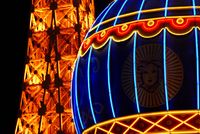Neon
 From Conservapedia
From Conservapedia | Neon | |
|---|---|

| |
| Neon lights on a balloon and Eiffel Tower, Paris Las Vegas Hotel & Casino, Las Vegas, Nevada | |
| Properties | |
| Atomic symbol | Ne |
| Atomic number | 10 |
| Classification | Group 18, Noble Gas |
| Atomic mass | 20.2 amu |
| Melting point (°C) | -248.67 |
| Boiling point (°C) | -245.92 |
| Density (grams per cc) | 0.9002 (per liter) 0.6962 (relative) |
| Abundance in lithosphere (%) | 1.8 x 10-8 |
| Other Information | |
| Date of discovery | 1898 |
| Name of discoverer | Sir William Ramsay Morris W. Travers |
| Name origin | Greek: νέος "neos" (new) |
| Uses | Lighting |
| Obtained from | Liquid air |
Neon (chemical symbol Ne, atomic number 10) is the fourth most abundant chemical element in the universe, but it is just a trace element in the air. As a member of the noble gas series, it is nearly inert. Under ordinary conditions, it is colorless, but in a vacuum discharge tube, it gives a reddish-orange glow. Consequently, the main use of neon is to make flashy signs for advertising.
| Periodic Table of the Elements | ||||||||||||||||||||||||
|---|---|---|---|---|---|---|---|---|---|---|---|---|---|---|---|---|---|---|---|---|---|---|---|---|
| 1 | 2 | 3 | 4 | 5 | 6 | 7 | 8 | 9 | 10 | 11 | 12 | 13 | 14 | 15 | 16 | 17 | 18 | |||||||
1
H 1.008 |
2
He 4.003 | |||||||||||||||||||||||
3
Li 6.939 |
4
Be 9.0122 |
5
B 10.811 |
6
C 12.011 |
7
N 14.007 |
8
O 15.999 |
9
F 18.998 |
10
Ne 10.183 | |||||||||||||||||
11
Na 22.99 |
12
Mg 24.312 |
13
Al 26.982 |
14
Si 28.086 |
15
P 30.974 |
16
S 32.064 |
17
Cl 35.453 |
18
Ar 39.948 | |||||||||||||||||
19
K 39.102 |
20
Ca 40.08 |
21
Sc 44.956 |
22
Ti 47.9 |
23
V 50.942 |
24
Cr 51.996 |
25
Mn 54.938 |
26
Fe 55.847 |
27
Co 58.933 |
28
Ni 58.71 |
29
Cu 63.546 |
30
Zn 65.37 |
31
Ga 69.72 |
32
Ge 72.59 |
33
As 74.922 |
34
Se 78.96 |
35
Br 79.904 |
36
Kr 83.8 | |||||||
37
Rb 85.47 |
38
Sr 87.62 |
39
Y 88.905 |
40
Zr 91.22 |
41
Nb 92.906 |
42
Mo 95.94 |
43
Tc [97] |
44
Ru 101.07 |
45
Rh 102.91 |
46
Pd 106.4 |
47
Ag 107.87 |
48
Cd 112.4 |
49
In 114.82 |
50
Sn 118.69 |
51
Sb 121.75 |
52
Te 127.6 |
53
I 126.9 |
54
Xe 131.3 | |||||||
55
Cs 132.91 |
56
Ba 137.34 |
57*
La 138.91 |
72
Hf 178.49 |
73
Ta 180.95 |
74
W 183.85 |
75
Re 186.2 |
76
Os 190.2 |
77
Ir 192.2 |
78
Pt 195.09 |
79
Au 196.97 |
80
Hg 200.59 |
81
Tl 204.37 |
82
Pb 207.19 |
83
Bi 208.98 |
84
Po 210 |
85
At 210 |
86
Rn 222 | |||||||
87
Fr 215 |
88
Ra 226.03 |
89**
Ac 227.03 |
104
Rf [261] |
105
Db [262] |
106
Sg [266] |
107
Bh [264] |
108
Hs [265] |
109
Mt [268] |
110
Dt [271] |
111
Rg [272] |
112
Cn [277] |
113
Nh [284] |
114
Fv [289] |
115
Mc [288] |
116
Lv [292] |
117
Ts [293] |
118
Og [294] |
|||||||
| *Lanthanides | 58
Ce 140.12 |
59
Pr 140.91 |
60
Nd 144.24 |
61
Pm 145 |
62
Sm 150.35 |
63
Eu 151.96 |
64
Gd 157.25 |
65
Tb 158.92 |
66
Dy 162.5 |
67
Ho 164.93 |
68
Er 167.26 |
69
Tm 168.93 |
70
Yb 173.04 |
71
Lu 174.97 |
||||||||||
| **Actinides | 90
Th 232.04 |
91
Pa 231 |
92
U 238.03 |
93
Np 237.05 |
94
Pu 239.05 |
95
Am 241.06 |
96
Cm 244.06 |
97
Bk 249.08 |
98
Cf 252.08 |
99
Es 252.08 |
100
Fm 257.1 |
101
Md 258.1 |
102
No 259.1 |
103
Lr 262.11 |
||||||||||
↧ Download as ZWI file | Last modified: 02/20/2023 05:05:49 | 12 views
☰ Source: https://www.conservapedia.com/Neon | License: CC BY-SA 3.0
 ZWI signed:
ZWI signed: KSF
KSF